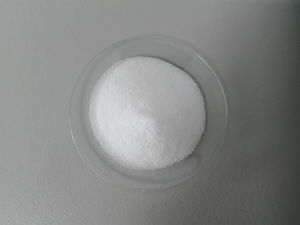Ethylenediaminetetraacetic acid
 EDTA sample on a watchglass
| |
| Names | |
|---|---|
| Systematic IUPAC name
2,2',2,2'-(Ethane-1,2-diyldinitrilo)tetraacetic acid | |
| Other names
EDTA
N,N'-Ethane-1,2-diylbis[N-( carboxymethyl)glycine] Fiaminoethane-tetraacetic acid Edetic acid Ethylenedinitrilo-tetraacetic acid Versene | |
| Properties | |
| C10H16N2O8 | |
| Molar mass | 292.24 g/mol |
| Appearance | Colorless crystalline solid |
| Odor | Odorless |
| Density | 860 g/cm3 (at 20 °C) |
| Melting point | 240 °C (464 °F; 513 K) (decomposes; decomposition begins above 150 °C) |
| Boiling point | Decomposition |
| 0.0162 g/100 ml (2.7 °C) 3.8 g/100 ml (25 °C) 9.381 g/100 ml (100 °C) | |
| Solubility | Soluble in aq. alkali |
| Vapor pressure | 1.5·10-12 mmHg (25 °C) |
| Acidity (pKa) | 1.782 |
| Thermochemistry | |
| Std enthalpy of
formation (ΔfH |
−1.7654 to −1.7580 MJ/mol |
| Hazards | |
| Safety data sheet | Sigma-Aldrich |
| Lethal dose or concentration (LD, LC): | |
| LD50 (Median dose)
|
1000 mg/kg (oral, rat) |
| Except where otherwise noted, data are given for materials in their standard state (at 25 °C [77 °F], 100 kPa). | |
| Infobox references | |
Ethylenediaminetetraacetic acid (more commonly EDTA) is a chemical compound with a variety of uses, in both chemistry and medicine, due to its ability to sequester metal ions.
Contents
Properties
Chemical
EDTA usually binds to a metal cation through its two amines and four carboxylates.
Physical
EDTA is an odorless white solid, soluble in water, but less so in organic solvents.
Availability
EDTA is available as both free acid or more commonly as disodium or tetrasodium salt. Chelated fertilizers have EDTA in their composition, but extraction may not worth the effort if they're too diluted.
Preparation
EDTA can be prepared by reacting ethylenediamine with chloroacetic acid.
Instead of chloroacetic acid, a mixture of formaldehyde and sodium cyanide can be used.
Projects
- Removal of heavy metals such as lead and mercury
- Water hardness and calcium determination
- Preservative for various reagents
- Separation of the lanthanide metals
Handling
Safety
EDTA isn't harmful to touch, though ingestion of large doses may lead to hypocalcaemia, due to the EDTA removing the Ca2+ ions from blood. Iron and other metals will also be removed, which may lead to mineral deficiency.
EDTA has low cytotoxic and genotoxic effect.
Storage
EDTA should be stored in closed bottles, away from corrosive reagents. Plastic or glass bottles are suitable.
Disposal
EDTA has low environmental impact, so it can be safely poured down the drain, though if it's binded to toxic metals, it may be a hazard to the environment and instead should be taken to hazardous waste disposal facilities.